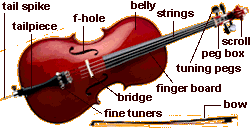
Modern orchestras can have as many as ten or twelve cellos, and you can usually hear and see them quite clearly to the right of the conductor. A cello can also play beautiful solos. When a cellist plays a solo with an orchestra, its lowest notes are hard to hear through all the other instruments. So cello solos usually feature the cello's sweet higher notes.

The neck extends out the upper end of the body.
On the neck is the fingerboard. The cellist presses the strings against the fingerboard to change their pitch.
The four strings stretch across the body and fingerboard of the cello, from one end to the other. They are made of steel, and each is tuned to a different pitch. Cello strings are thicker than violin and viola strings.
The cello has four tuning pegs - each string is threaded through its own peg. The pegs can be turned to tighten or loosen the strings, changing their pitch.
The tail piece attaches the strings to the other end of the cello.
The endpin is a spike that extends out the bottom end of the cello. The cellist balances the instrument on it. The endpin slides into the body of the cello when it is not in use.
To get the most accurate pitch possible for each string, four fine tuners are also used in addition to the tuning pegs. Fine tuners are small screws that sit at the upper end of the tail piece.
The bridge supports the strings and transmits their vibrations to the body of the cello. It is made of wood, and is curved so that you can bow each string separately. It is much bigger on a cello than on a violin or viola.
The soundholes are called f-holes because of their shape. They help the body of the cello to vibrate, and help release the vibrating air inside the instrument. This makes the cello sound louder.
The bow is made of horsehair attached to a rod. When the horsehair touches the strings of the cello, they vibrate, creating a pitch.
![]()
